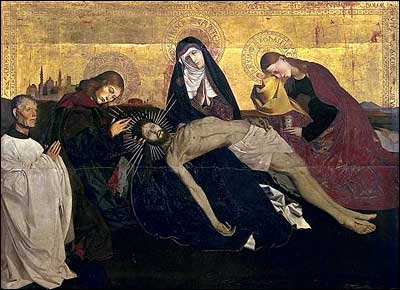
Enguerrand Quarton, La Pietà d'Avignon, Louvre Museum RF 1569 © RMN/ R. G. Ojeda |
|
Musée du Louvre
Richelieu Wing, Mezzanine
Palais du Louvre 75001 Paris
Information
Tel. 01 40 20 53 17
Site : www.louvre.fr
Hours of admission :
Everyday except Tuesday
9 am to 5.30 pm.
Late opening till 9.30 pm on Wednesday.
Curator :
Dominique Thiebault,
senior curator at the Louvre.
Entrance Fees :
Free with Permanent collection ticket
(€ 8,50 Concessions € 6).
Free : under 18s, Louvre Jeune and Amis du Louvre card-holders, History of Art and Fine Art teachers and students, disabled and unemployed.
Contacts :
Communications
Aggy Lerolle : Tel : 01 40 20 51 42
Press relations
Pascale Bernheim : Tel / Fax : 01 43 25 31 38 e-mail : Bernheim@louvre.fr

|
The memorable French Primitives exhibition organized in Paris in 1904 at the National Library and the Louvre's Marsan Pavilion, was a huge public success. A hundred years later, this exhibition is designed to recapture the sense of that event. First and foremost though, it aims at providing an account of what History of Art has achieved since then in a field which - particularly regarding the fifteenth century - has been rich in discoveries. It is also a unique opportunity to see or see again, some of the most remarkable masterpieces of fifteenth century European art.
Works ignored or actually unknown
1904 was the year in which a proper critical approach to the study of the paintings and illuminated manuscripts of the period was begun. The last twenty years were marked by the discovery of works long ignored or actually unknown. Paintings, such as Enguerrand Quarton's Avignon Pietà or Barthélémy d'Eyck's Aix Annunciation triptych, exceptionnally put together and shown in Paris for the fist time since 1927, as well as a wide variety of other craftwork - illuminated manuscripts, drawings, tapestries, stained-glass, embroidery - form the basis of an exhibition designed to trace the careers of French primitive artists and provide an appraisal of today's critical situation.
The intensity of artistic exchanges
The exhibition highlights the intensity of artistic exchanges throughout Europe
in the period together with an evocation of some particularly fertile centres of artistic activity. Paris from 1430 to 1500, a period during which the city recovered its status as artistic capital after a long stagnation due to the Hundred Years' War Or Avignon and Aix in Provence, with towering figures such as Enguerrand Quarton and Barthélemy d'Eyck. It also pays a special tribute to a remarkable figure, scarcely known outside expert circles, Jean Poyer from the Loire Valley, the only one of Fouquet's disciples to have understood the full extent of his brilliant predecessor's achievements.
Publication
Exhibition catalogue French Primitives : Discoveries and Rediscoveries
by Dominique Thiébaut, Senior Curator at the Louvre, with François-René Martin and Philippe Lorentz, 192 p. Editions RMN € 35.
|








